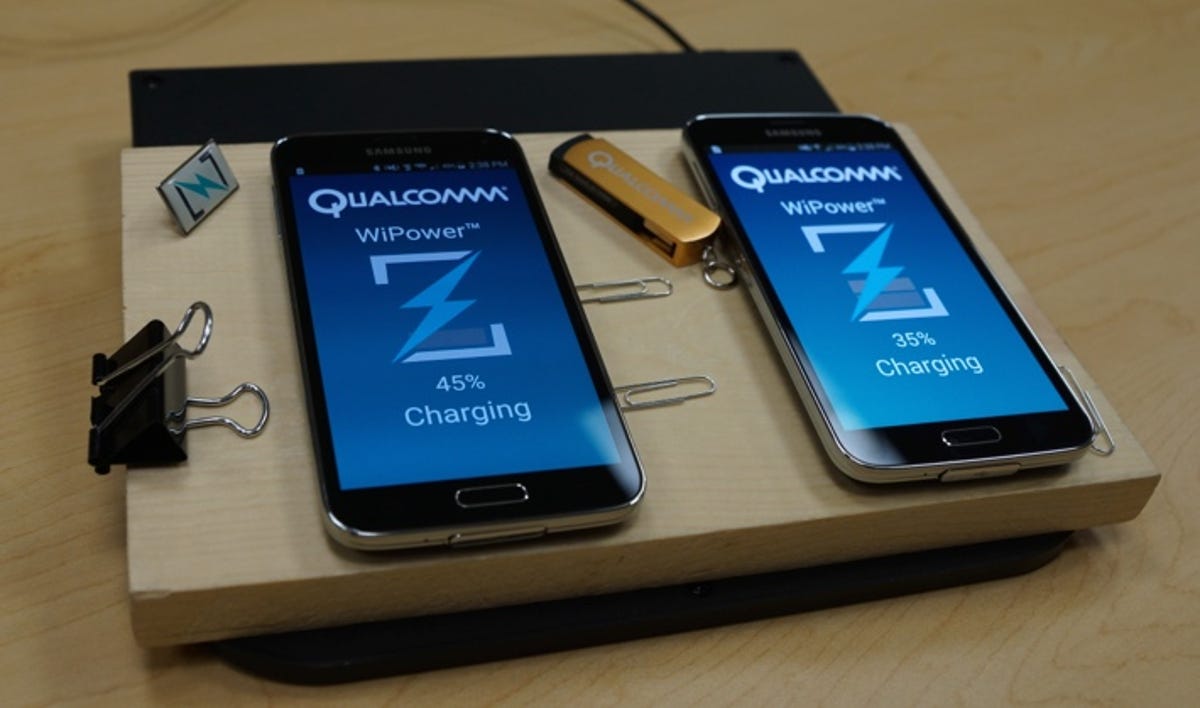

Now playing:
Watch this:
Charge me up, Scotty! Qualcomm’s WiPower in action
1:31
Wireless charging is one of those great technologies that’s still struggling to catch hold. A new method for charging your devices is just about ready for action.
Sometimes branded as Rezence, it uses magnetic resonance to throw a charge over a small three-dimensional space. Instead of inductive charging, where you need to place the phone or tablet directly on the pad to charge it (this is the Qi type of charging, by the way), resonance charging shoots a magnetic field up through the surface to reach your device, say a phone or wearable.
The bottom line for you: you don’t have to worry about clearing off part of your table or desk for a large charging pad. Instead, a resonance charger can be screwed or even taped underneath a surface, like a table or countertop, which means that you will be able to reclaim that space.
How well does it work?
CNET got a chance to see two pre-commercial devices at Qualcomm’s headquarters in San Diego. In the first demo (watch it in the video above), I placed a wooden block that represented a table surface on top of the plastic pad that generates charge.
Related stories
- Say hello to Rezence, your new wireless charging brand
- Key wireless charging groups A4WP, PMA agree to merge
- Glowing wireless charger is a bright idea, for some
Next, I placed phones and a Bluetooth device on top of that, both singly and in combination, tossing on metal objects like paper clips and USB drives to see how that affected the charge.
Instead of the metal objects heating up as they might with an induction charger (or an induction stovetop) — or the charge stopping to keep you from handling the ultrahot metal — the devices kept on taking in current.
The second demo device converts from a flat pad into is a standup dock with a shelf to hold a tablet; in this case, one that Qualcomm made to demo this type of wireless charging. In truth, there isn’t much to these demos — but so far, so good.
It wasn’t possible in such a short time to gauge how quickly or how efficient the devices topped up, but Qualcomm says the charging rate should be comparable to a standard charger, though slower than its QuickCharge technology.
How it works
How does it all work? This type of charging, which relies on the A4WP standard of specification for wireless charging, generates a magnetic field using an antenna and coils found in both the charging station and the device. Ferrite shielding directs the magnetic field back into a resonator (the antenna).

Jessica Dolcourt/CNET
It isn’t just enough to create the charging field, though. You have to “tune” the resonator surface to make sure that it reaches far enough above to surface to power the device through a tabletop. The average conference room table is between 25 and 40 millimeters, says Qualcomm’s Mark Hunsicker, senior director of wireless power solutions.
Your device may already have it inside
Two things need to happen for this to work on your tablet or phone. First, you’ll have to install or be near a wireless charging pad of this sort. Second, the device-maker or case-maker would have to embed the right hardware, including a chip like Qualcomm’s.


Josh Miller/CNET
The good news is that Qualcomm is already integrating magnetic resonance charging capabilities — which it calls WiPower — into its chips, like the Snapdragon 810 processor that’s found inside the LG G Flex 2. Since WiPower is a technology that Qualcomm licenses, your device won’t automatically access WiPower; it’s something hardware-makers have to turn on.
TVs and furniture too, and coming soon
The WiPower charging I demoed isn’t only coming to mobile electronics, Qualcomm’s Hunsicker said. It’s also suited to consumer electronics like cameras, tabletop lamps and bluetooth speakers. Imagine a wall-mounted TV that’s cable-free because it draws power wirelessly, and armchair furniture that contains a surface for charging up your devices as soon as you lay them down by your side.
Magnetic resonance charging like this is on track to surface in the second half of 2015.



